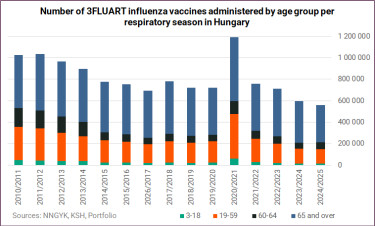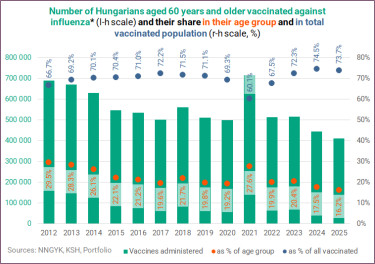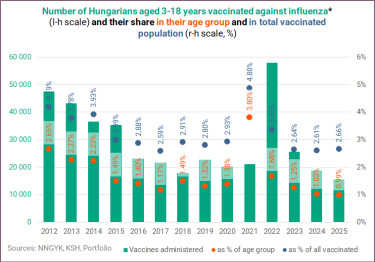Influenza shots already available in Hungary

The NNGYK stressed in a statement on Monday that
Vaccination is the most effective way to prevent severe cases of influenza that can lead to complications.
With the influenza virus spreading rapidly, protection is particularly timely in autumn, before it reaches epidemic proportions. Vaccination is particularly important for those at risk due to age or health conditions. This includes
- people over the age of 60;
- those with chronic respiratory, cardiovascular or metabolic diseases;
- people with compromised immune systems; and
- women who are pregnant or planning to have children.
The vaccine is also recommended for healthcare and social care workers, as well as for people living in long-term care facilities. As in previous years, the vaccine is free for those in the above risk groups.
The influenza virus is highly variable, meaning a new vaccine must be produced every season.
In Hungary, 650,000 free doses of the 3Fluart vaccine are available for children over three years of age, while 4,000 doses of the Vaxigrip vaccine and 2,000 doses of the Fluenz nasal spray are available for children under three years of age. The trivalent vaccine contains two influenza A and one influenza B virus strain, and its composition complies with the World Health Organization's (WHO) and the European Medicines Agency's recommendations for the 2025/26 season.
In the previous two season, 949,000 doses of the 3Fluart flu vaccine were available for the at-risk group of people aged 3 years and over. The doses available now are expected to be enough, as Hungarians are not particularly keen on getting flu jabs (see details below).
Based on recent decades' experience,
influenza viruses begin to spread in Hungary at the end of November, usually reaching epidemic levels by January.
Read the latest respiratory infection statistics at the link below:
It is advisable to get the flu vaccine before the virus starts to circulate, to allow enough time for immunity to develop. This can help to prevent serious flu-related illness, which may require hospital treatment.
In addition to the free vaccines, flu vaccines are available to purchase with a prescription from pharmacies.
Hungarians' slackening inclination to get vaccinated
We have already reported on vaccination rates for the 2024/2025 season about a month ago, but the NNGYK has just released updated figures. These showed that 557,184 people got the free flu jab, which number is about 49,000 larger than what the NNGYK informed us about at the end of September.
The reason behind the discrepancy is simple, though. A month ago, the NNGYK reported free-of-charge influenza vaccination figures for a 110-day period between 9 October 2024 and 26 January 2025, for the so-called first accounting period. The new figure, however, is the final data, including vaccinations administered up to 30 April, i.e. an additional 94-day period.
This means that about 4,620 free flu shots were administered during the 'high season', while the daily average dropped to 522 between 26 January and 30 April.
A total of 557,184 free-of-charge 3Fluart influenza vaccines were administered in Hungary in the 2024/2025 respiratory season, a period between the 40th and 20th weeks of two consecutive years that many (mistakenly) call the flu season.
This is the lowest number of flu shots received since 2010/2011.

Given that the main risk group is people aged 60 and over, we have looked at how they felt about taking their chances against the flu without a jab.
The number of flu jabs administered to those aged 60 and over was at an all-time low of 410,570, which corresponded to 73.7% of all Hungarians vaccinated with the free 3Fluart shot, which marks just a 7.3% decrease from last year. This means that about three quarters of those asking for the free flu shot were aged 60 and over in the last respiratory season.
However, merely 16.2% of the 60+ age group felt the need to get the seasonal flu shot, which is
the lowest figure on record and way below the earliest comparable figure of 29.5% for the 2011/2012 season.
This means that out of 100 Hungarians aged 60 and over, only 16 felt the need to protect themselves against the flu via vaccination.

The rapidly waning willingness to get vaccinated against influenza is are even more dramatic when we look at the share of vaccinated Hungarians as a percentage of the (otherwise shrinking) population.
In the 2024/2025 respiratory season, merely 6.0% of Hungarians felt the need to get the free flu shot, the lowest share on record.

The 3-18-year age group accounted for only 2.7% of all Hungarians vaccinated against influenza (with the free 3Fluart shot) in the 2024/25 season. About 14,500 or only 1% of this age group (or their parents) chose they needed a flu jab.

Cover image (for illustration purposes only): Getty Images







